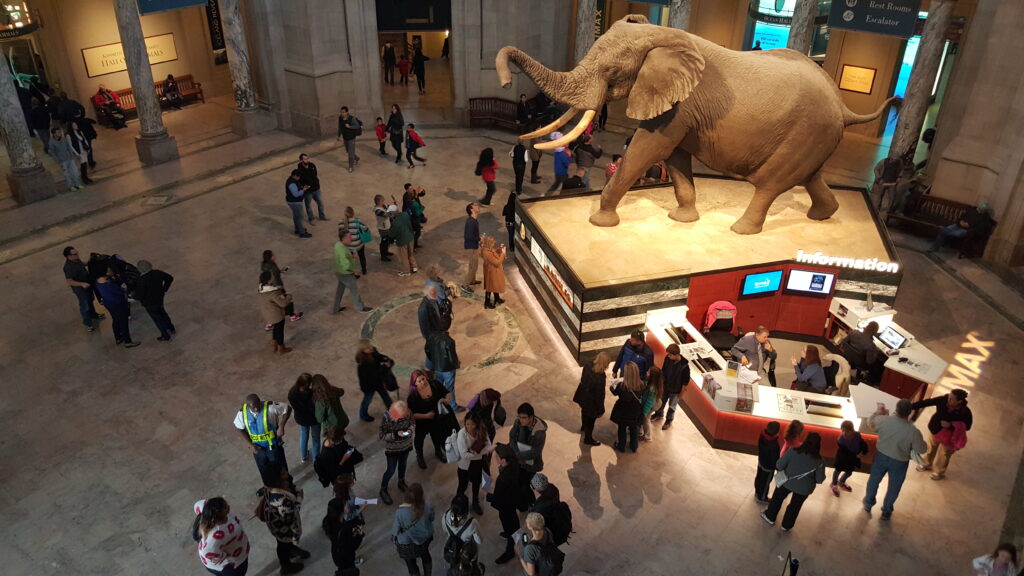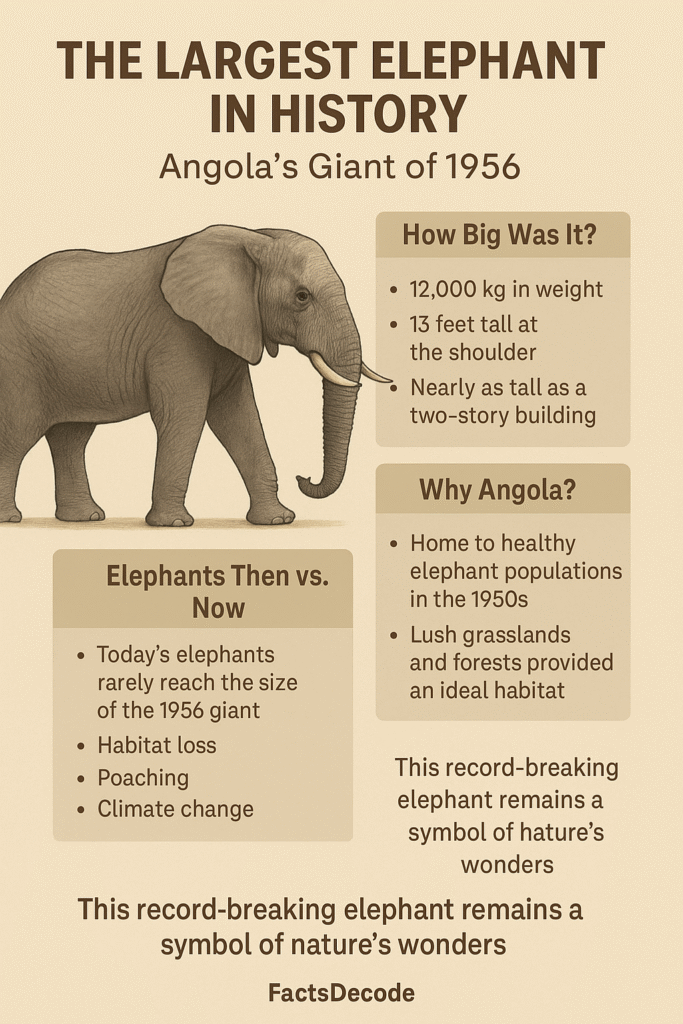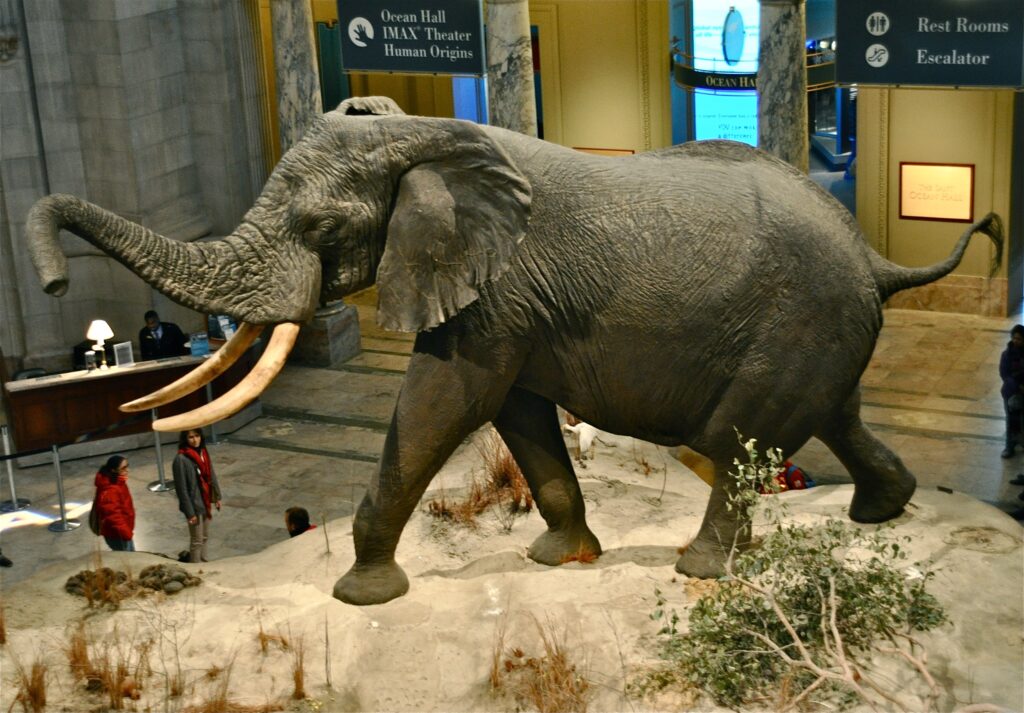Introduction – A Giant That Stunned the World
In 1956, deep in the wilds of Angola, hunters came across an elephant so enormous it stunned the world. This African bush elephant wasn’t just big — it became the largest elephant ever recorded in history, standing nearly 13 feet tall at the shoulder and weighing an estimated 12,000 kilograms (26,000 pounds). To this day, no other elephant has surpassed this incredible record.
This legendary giant is more than a fascinating fact from history — it’s a reminder of how powerful nature once was and why protecting today’s elephants matters more than ever.

How Big Was the 1956 Angola Elephant – The Largest Ever Recorded?
To give you an idea, the Angolan elephant, it was estimated that to weigh around 12,000 kilograms (26,000 pounds) and the height was nearly 13 feet tall at the shoulder.
To understand this let’s break it down:
- Imagine something as tall as a two-story house — that’s how high its shoulders were.
- Its body mass was close to twice the weight of a city bus.
- Even its tusks, each one weighing hundreds of pounds on its own.
With numbers like that, it easily became the largest African bush elephant (Loxodonta Africana) ever recorded.

Where is the Angola Giant now?
As per the article in ‘animalsaroundtheglobe’, after the hunters encountered this record-breaking elephant in 1956, they shot it and carefully recorded its size and weight. Just a few years later, in 1959, the elephant’s skin was donated to the Smithsonian Institution in Washington, D.C. Today, this legendary elephant—affectionately nicknamed “Henry”, or the “Giant of Angola”—has been on display for more than six decades at the Smithsonian’s National Museum of Natural History. Millions of visitors come every year to see Henry, making him one of the most iconic exhibits and a lasting reminder of the largest elephant ever recorded.

Why Angola Produced the World’s Largest Elephant in 1956
Back in the day, Angola in southern Africa was basically an elephant’s paradise. There were endless grasslands, rivers that never seemed to run dry, and thick forests offering plenty of shade. For a giant like this, it was the perfect setup to eat, roam, and just be wild.
In the 1950s, elephant herds were far larger and healthier than what we see now. Why? Simply because the threats that hammer them today — shrinking habitats, human expansion, and heavy poaching — hadn’t taken over yet.
This record-breaking elephant simply had the perfect setup. Plenty of space to roam, water to drink, and endless food to munch on. It’s no wonder it grew into a giant that still amazes us even after all these years.
Elephants in 1956 vs. Today – Why They Don’t Grow as Large
Sadly, elephants today almost never grow as large as the legendary Angolan giant. And there are some pretty clear reasons why:
- First, there’s habitat loss. As farmland stretches further and cities keep expanding, elephants are left with smaller and smaller spaces to live in.
- Then comes poaching — the demand for ivory has been devastating, wiping out huge numbers of elephants over the last century.
- You can’t forget climate change either. These days, the rains don’t come when they should, and droughts drag longer, Rivers are dry up, grasslands turn bare, and elephants are left wandering further just to find a sip of water or a patch of food.
For them, it’s not about growing big anymore — it’s about surviving day to day.
When you add that on top of shrinking habitats and relentless poaching, it’s no wonder we don’t see elephants growing into the kind of giants that once roamed Angola back in 1956.
Conservationists believe that if protected properly, elephants might once again evolve to reach larger sizes — though the Angola giant may remain unmatched in history
What We Can Learn from the Largest Elephant Ever Recorded
The story of the Angola elephant is more than just a fascinating fact — it’s a reminder of:
- The richness of biodiversity Africa once held.
- The importance of wildlife conservation to prevent losing more giants.
- How nature often surprises us with records that may never be broken.
Conclusion – The Legacy of the World’s Largest Elephant
Back in 1956, that Angolan elephant wasn’t just another record in the books — it was the kind of story people passed around because they almost couldn’t believe it. An animal so huge it felt unreal. Till now, its been decades but we are still talking about it.
What do you think? Will the world ever see another one like that? I believe – NO. With habitats shrinking and all the problems elephants are dealing with these days, it’s hard to imagine another one reaching that size. Feels unlikely, if I’m honest. But then again, nature has pulled off surprises before — and who’s to say it couldn’t happen again?
One thing’s for sure — that elephant’s story is a reminder of why protecting wildlife actually matters. Because once these giants are gone, they’re gone for good.
FAQs About the Largest Elephant Ever Recorded
👉 The largest elephant ever recorded was an African bush elephant found in Angola in 1956. It stood nearly 13 feet tall at the shoulder and weighed about 12,000 kg (26,000 lbs), making it the biggest elephant in history.
👉 The world’s largest elephant was discovered in Angola, Africa, in 1956.
👉 No. Modern elephants are generally smaller due to habitat loss, poaching, and environmental changes. None have matched the size of the 1956 Angola giant.
👉 The record-breaking Angola elephant was an African bush elephant (Loxodonta africana), the largest land animal on Earth.
👉 The main differences are:
Size: African elephants grow larger (up to 13 ft), while Asian elephants average 9–10 ft.
Ears: African elephants have big, fan-shaped ears; Asian elephants have smaller, rounded ears.
Tusks: Both male and female African elephants may have tusks, but in Asian elephants usually only males grow them.
Head shape: African elephants have a rounded forehead, while Asian elephants have a twin-domed head.
Back shape: African elephants have a concave (saddle-shaped) back; Asian elephants have a more arched back.
👉 In short: African elephants are larger with bigger ears and tusks in both sexes, while Asian elephants are smaller with distinct head and back shapes.
